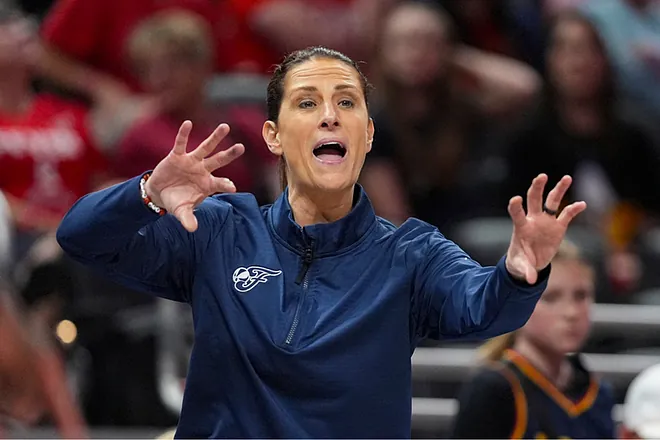The Indiana Fever’s season has been one of the most closely followed storylines in all of basketball, largely because of rookie phenom Caitlin Clark, whose arrival in the WNBA was supposed to signal a new era for the franchise. But now, as injuries cloud Clark’s future and questions mount over coaching decisions and communication breakdowns, the team is finding itself in the center of a storm of confusion, mistrust, and public scrutiny.
Whispers of tension inside the Fever locker room have turned into audible concerns, fueled by contradictory comments from head coach Stephanie White and uncertainty over Clark’s health status. What began as a promising season built on hype, fanfare, and expectations is now tilting toward dysfunction, with fractures beginning to show both on and off the court.
It all began with what was initially described as a “minor physical issue” concerning Caitlin Clark. The team downplayed the situation, suggesting that the Iowa legend and No. 1 overall draft pick was just “managing her body” as she adjusted to the WNBA’s physicality. But as Clark’s minutes fluctuated, her performances dipped, and reports of her battling pain surfaced, fans and insiders began to question whether they were being told the full story.
Clark, known for her competitive fire and iron-willed durability in college, had rarely missed time at Iowa. Seeing her hesitate, sit during key stretches, and sometimes grimace through games left viewers uneasy. More alarming, however, were the conflicting narratives coming out of the Fever camp. Head coach Stephanie White initially suggested there was “nothing serious” going on, even brushing off questions about injury concerns. But within a matter of days, she reversed course, acknowledging that Clark was “playing through something” and that the team was “monitoring her workload.”
That discrepancy didn’t go unnoticed.
The WNBA media corps, already on high alert due to the magnitude of Clark’s profile, pounced. Analysts pointed to the team’s vague injury updates and murky language in press conferences. Even rival coaches privately questioned what exactly was happening with Clark’s health. Was this a strategic smokescreen to protect their rookie star, or was there a larger miscommunication—or worse, mismanagement—unfolding behind the scenes?
Further complicating matters, internal sources report that members of the Fever roster have grown uneasy with how the situation has been handled. Some believe that Clark’s injury—or injuries—are more significant than publicly disclosed, while others are reportedly frustrated with the lack of transparency from the coaching staff. In a league where trust is everything, especially between players and coaches, that erosion of confidence can be catastrophic.
Adding to the drama is the unique pressure placed on Clark from all sides. She didn’t just enter the league as a rookie—she came in as the face of a franchise, a television ratings magnet, and a cultural icon. The expectations on her shoulders have been unprecedented, and some within the league argue that the Fever may be pushing her too hard, too soon.
There’s also a commercial layer to this controversy. With Clark’s name attached to major sponsorship deals and massive ticket sales, there’s reason to believe external pressure is being placed on the franchise to keep her on the floor at all costs. That’s a dangerous line to walk, especially if her long-term health is being compromised in service of short-term gains.
One WNBA executive, speaking anonymously, warned that “this is exactly how great careers get derailed before they even begin. If Caitlin’s not 100%, let her heal. The league will survive a few missed games, but it won’t recover from losing its brightest star to chronic injury.”
The backlash has already begun among fans and commentators. Social media is ablaze with theories, criticisms, and outright anger. Fever supporters are demanding clarity, while Clark’s loyal base from Iowa is increasingly protective of her well-being. Questions about the franchise’s priorities—winning games versus protecting players—are being asked louder and more frequently.
And then there’s Stephanie White. The Fever’s head coach, who returned to Indiana with high hopes and deep ties to the organization, is now in a precarious position. Her early-season statements about building a culture of transparency and player empowerment are being thrown back at her in press conferences. White has attempted to clarify her past comments, but each clarification seems to raise more questions than answers.
She recently told reporters, “We’re not hiding anything. Caitlin’s a competitor and wants to play, but we’re making decisions that are best for her and the team.” The vagueness of “best for her and the team” only fueled speculation further. If Clark is injured, why is she still playing? And if she isn’t injured, why all the cloak and dagger?
Meanwhile, Clark herself has tried to stay above the fray. In public statements, she’s been poised and diplomatic, offering only that she’s “feeling okay” and “focused on helping the team win.” But her body language during games—limping slightly after tough drives, taking fewer explosive cuts, and sometimes avoiding contact—tells a different story. She is, by all appearances, fighting through something.
What’s also becoming apparent is the stress this uncertainty is placing on the rest of the team. Teammates who once looked to Clark as a confident floor general are now left wondering whether she’ll be available at full strength from game to game. The chemistry, which was shaky at best early in the season, has only become more fragile. Players like Aliyah Boston, who was expected to form a dynamic one-two punch with Clark, have shown visible signs of frustration during games.
From a broader league perspective, this situation is a cautionary tale about the price of superstardom in the modern era of women’s basketball. The WNBA has made significant strides in visibility and marketability thanks to players like Caitlin Clark. But with that spotlight comes intense scrutiny and pressure—on players, coaches, and front offices alike.
The Fever are now at a crossroads. They can continue to downplay the situation, risking both Clark’s health and the team’s credibility, or they can pivot toward transparency and prioritize the long game. Either choice comes with consequences, but one has a significantly higher moral and professional ground.
There’s also the question of how the league office views this. The WNBA has historically left injury disclosures to individual teams, but with the profile of Clark and the national attention she commands, many believe it’s time for the league to implement a more standardized approach. A lack of clear information not only undermines fan trust but can potentially hurt the league’s overall growth.
Right now, the Indiana Fever are in the middle of a PR and competitive minefield. And at the center of it all is Caitlin Clark—a player who’s done everything right, but whose body may be calling for a timeout, even if her heart won’t allow it. If her injury is more serious than disclosed, the consequences of pushing her through it could be devastating—not just for the Fever, but for women’s basketball as a whole.
The coming weeks will be pivotal. Clark’s status, White’s handling of the team, and the organization’s response to mounting public pressure will all define how this season—and potentially this era—of Indiana Fever basketball is remembered. The foundation of a dynasty may have been laid with the drafting of Caitlin Clark, but that foundation is already showing cracks.
In a league finally getting the attention and respect it has long deserved, this is not just a team crisis—it’s a WNBA crisis. The time for truth, clarity, and care is now. Because if Caitlin Clark falls, so too does the fragile hope that this generation of women’s basketball is truly different.



